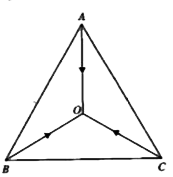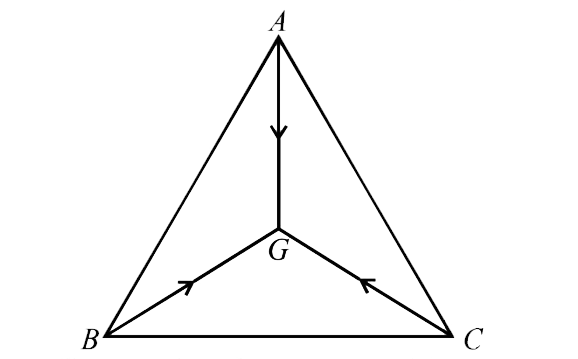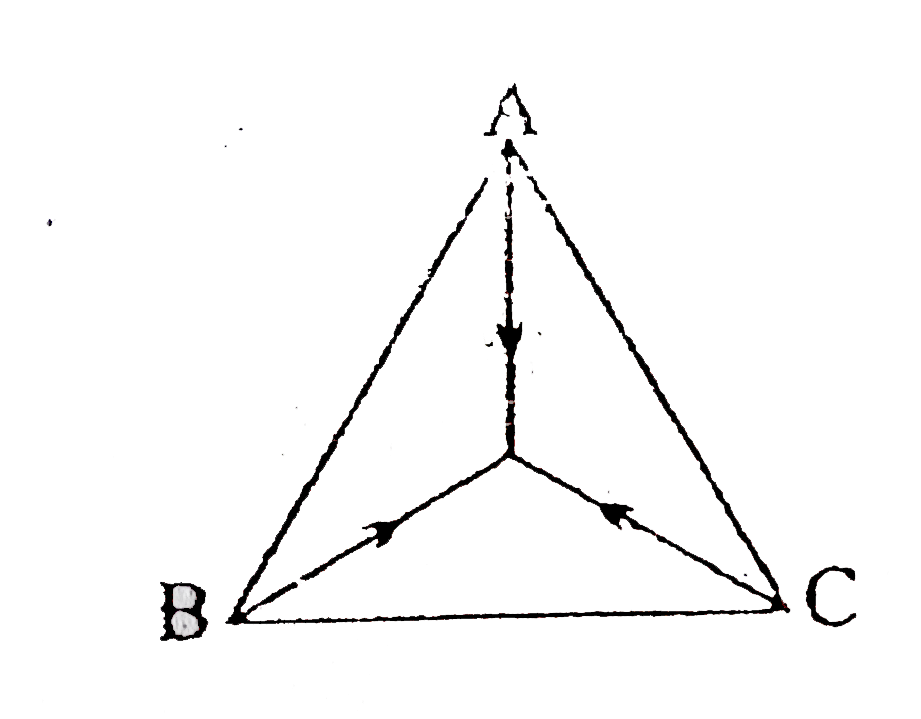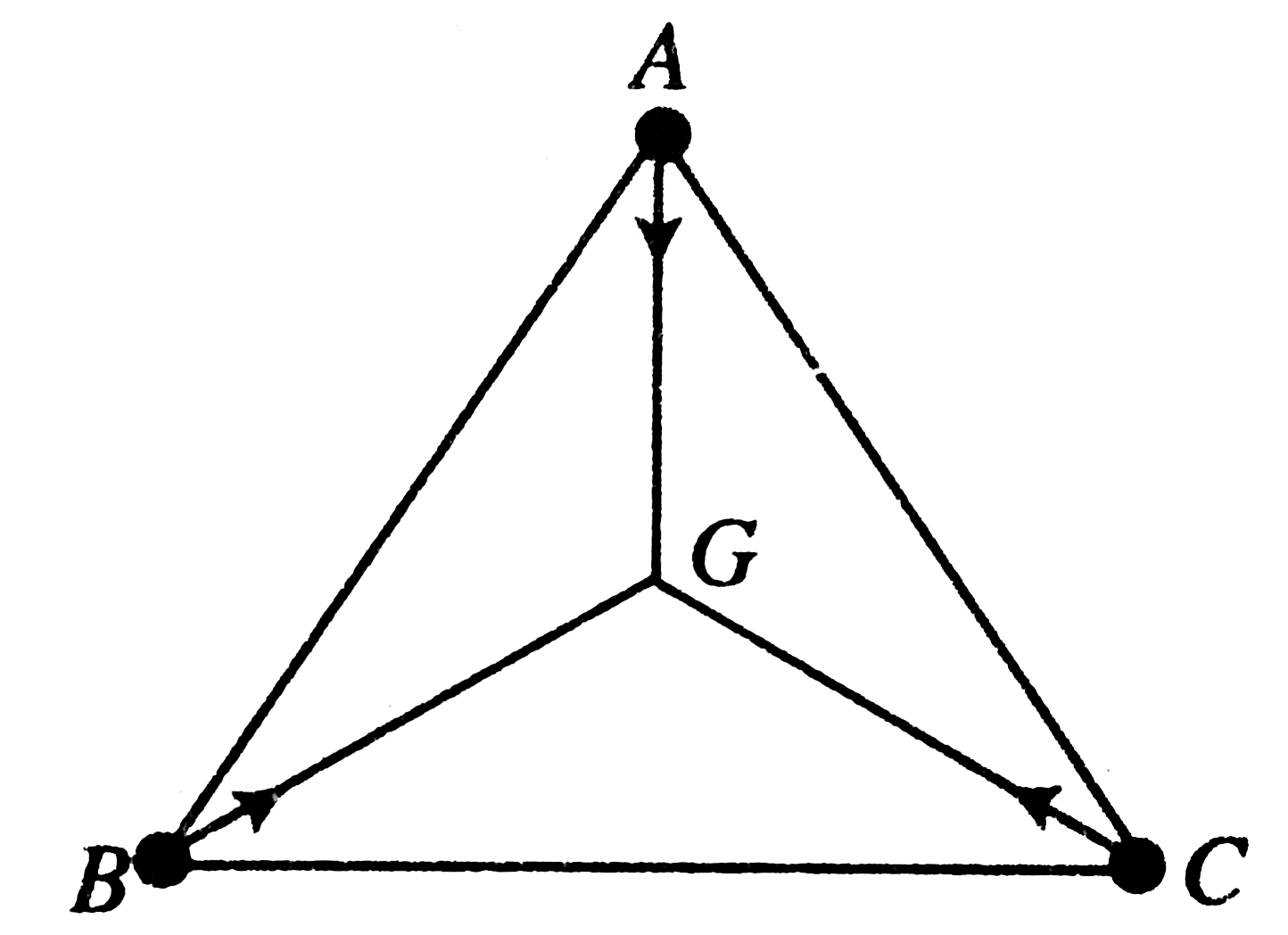Three particles A, B, C of equal masses, moving with same speed v along the medians of an equilateral triangle, collide at the centroid of the triangle. After collision, A comes to rest and B retraces its path with speed v. What is the speed of C after collision?
PA=PB=PC=mv
These three momenta can be represented by the three sides of a triangle taken in order. So their resultant must be zero i.e., Total momentum before collision is zero. So total momentum after collision must be zero. PA=0,PB is along OB. So PC must be opposite to OB or along BO. Hence the speed of c after collision is v.

Topper's Solved these Questions
- BOOK - ICSECHAPTER - DYNAMICSEXERCISE - SHORT ANSWER QUESTIONS WITH ANSWERES43videos
DYNAMICS
- BOOK - ICSECHAPTER - DYNAMICSEXERCISE - SHORT ANSWER QUESTIONS WITH ANSWERS12videos
DYNAMICS
- BOOK - ICSECHAPTER - DYNAMICSEXERCISE - VERY SHORT ANSWER QUESTIONS60videos
DYNAMICS
- BOOK - ICSECHAPTER - DIMENSIONSEXERCISE - SELECTED PROBLEMS (FROM CONVERSIONS OF ONE SYSTEMS OF UNITS INTO ANOTHER)9videos
DIMENSIONS
- BOOK - ICSECHAPTER - FRICTIONEXERCISE - Selected problems30videos
FRICTION
Similar Questions
Three particles A, B and C of equal mass move with equal speed V along the medians of an equilateral triangle as shown in hgure. They collide at the centroid G of the triangle. After the collision, A comes to test, B retraces its path with the speed V. What is the velocity of C ?
 View Solution
View SolutionThree particles A, B and C of equal mass move with equal speed V along the medians of an equilateral triangle as shown in hgure. They collide at the centroid G of the triangle. After the collision, A comes to test, B retraces its path with the speed V. What is the velocity of C ?
 View Solution
View Solution
Knowledge Check
- Question 1 - Select One
Three particles A, B and C of equal mass move with equal speed V along the medians of an equilateral triangle as shown in hgure. They collide at the centroid G of the triangle. After the collision, A comes to test, B retraces its path with the speed V. What is the velocity of C ?
 Av along BGBv2alongGBCZeroDv along CG
Av along BGBv2alongGBCZeroDv along CG - Question 2 - Select One
Three particles with equal mass move with equal speed v along the medians of an equilateral triangle as shown. They all collide at the centroid simultaneously. After the collision. A comes to rest, B retraces it's path with same speed. What is speed of C after the collision?
 AvBv/2C2vDinformation ijnsufficient
AvBv/2C2vDinformation ijnsufficient - Question 3 - Select One
Three particles A, B and C of equal masses, moving with the same speed 'v' along the medians of an equilateral triangle, collide at the centroid G of the triangle. After collision, A comes to rest B retraces its path with a speed 'v'. The speed of C after the collision is
 AIt iretraces its pathBthe direction in which A cam fromCdoes no haveDopposite to B
AIt iretraces its pathBthe direction in which A cam fromCdoes no haveDopposite to B
Three particles A, B and C of equal mass move with equal speed 10 m/sec along the medians of an equilateral triangle as shown in the figure. They collide at the centroid G of the triangle. After the collision, A comes to rest, B retraces its path with the speed 10 m/sec. The velocity of C is _______ m/sec.
 View Solution
View SolutionThree particlesA,B and C of equal mass move with equal speed V=5ms−1 along the medians of an equilateral triangle as shown in the figure. They collide at the centroid G of the triangle. After the collision, A comes to rest, B retraces its path with the speed V=5ms−1. What is the speed of C?
 View Solution
View SolutionThree particlesA,B and C of equal mass move with equal speed V=5ms−1 along the medians of an equilateral triangle as shown in the figure. They collide at the centroid G of the triangle. After the collision, A comes to rest, B retraces its path with the speed V=5ms−1. What is the speed of C?
 View Solution
View SolutionThree particles of equal masses are initial at the vertices of equilateral triangle of side 2√3m in horizontal plane. They start moving towards centroid O with equal speed 2m/sec. After collision at O, A stops and C retraces its path with same speed. Distance between B and C just after one second of the collision is αm. Here α is an integer. Find α.
 View Solution
View SolutionThree particles each of mass m are located at the vertices of an equilateral triangle ABC. They start moving with equal speeds each along the medians of the triangle and collide at its centroid G. If after collision, A comes to rest and B retraces its path along GB, then C (A) also comes
View Solution

